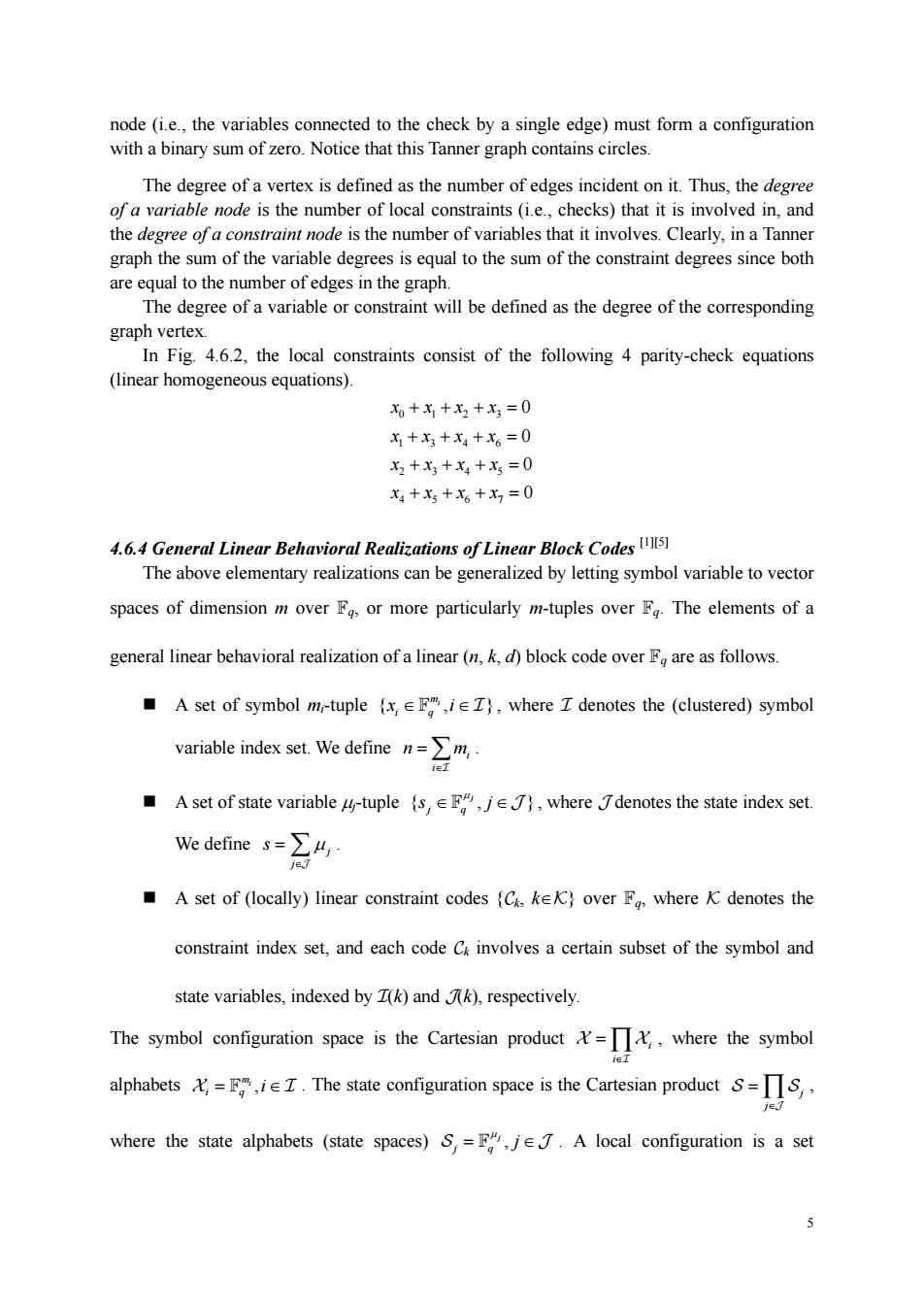正在加载图片...

node (i.e.the variables connected to the check by a single edge)must form a configuration with a binary sum of zero.Notice that this Tanner graph contains circles. The degree of a vertex is defined as the number of edges incident on it.Thus,the degree of a variable node is the number of local constraints(ie.,checks)that it is involved in,and the degree ofa constraint node is the number of variables that it involves.Clearly,in a Tanner grap the sum of the variable degrees isquoth sum of the ornt degreessine both qual to the number of edges in the graph. The degree of a variable or constraint will be defined as the degree of the corresponding graph vertex. In Fig.4.6.2.the local constraints consist of the following 4 parity-check equations (linear homogeneous equations). 6+写+x2+x3=0 +为+x+x6=0 2+x+x+x=0 ++x+x=0 4.6.4 General Linear Behavioral Realizations f Linear Block Codes The above elementary realizations can be generalized by letting symbol variable to vector spaces of dimension m over F.or more particularly m-tuples over Fg.The elements of a general linear behavioral realization of a linear(n,k,d)block code overF are as follows. A set of symbol m-tuple (x,i),where I denotes the (clustered)symbol variable index set.We define nm A set of state variable u-tuple (,where Jdenotes the state index set We defines=∑H, A set of (locally)linear constraint codes (C,kek)over F where K denotes the constraint index set,and each code C involves a certain subset of the symbol and state variables,indexed by (k)and )respectively. The symbol space is the Cartesian producthere the symbol alphabetsi.The state configuration space is the Cartesian product where the state alphabets (state spaces)s=F.A local configuration is a set 5 5 node (i.e., the variables connected to the check by a single edge) must form a configuration with a binary sum of zero. Notice that this Tanner graph contains circles. The degree of a vertex is defined as the number of edges incident on it. Thus, the degree of a variable node is the number of local constraints (i.e., checks) that it is involved in, and the degree of a constraint node is the number of variables that it involves. Clearly, in a Tanner graph the sum of the variable degrees is equal to the sum of the constraint degrees since both are equal to the number of edges in the graph. The degree of a variable or constraint will be defined as the degree of the corresponding graph vertex. In Fig. 4.6.2, the local constraints consist of the following 4 parity-check equations (linear homogeneous equations). 0123 1346 2345 4567 0 0 0 0 xxxx xxxx xxxx xxxx + ++= + ++= + ++= + ++= 4.6.4 General Linear Behavioral Realizations of Linear Block Codes [1][5] The above elementary realizations can be generalized by letting symbol variable to vector spaces of dimension m over Fq, or more particularly m-tuples over Fq. The elements of a general linear behavioral realization of a linear (n, k, d) block code over Fq are as follows. A set of symbol mi-tuple { ,} mi i q x i ∈ ∈ F I , where I denotes the (clustered) symbol variable index set. We define i i n m ∈ = ∑ I . A set of state variable μj-tuple { , } j j q s j μ ∈ ∈ F J , where J denotes the state index set. We define j j s μ ∈ = ∑ J . A set of (locally) linear constraint codes {Ck, k∈K} over Fq, where K denotes the constraint index set, and each code Ck involves a certain subset of the symbol and state variables, indexed by I(k) and J(k), respectively. The symbol configuration space is the Cartesian product i i∈ =∏ I X X , where the symbol alphabets , mi i q X I = ∈ F i . The state configuration space is the Cartesian product j j∈ =∏ J S S , where the state alphabets (state spaces) , j j q j μ S J = F ∈ . A local configuration is a set